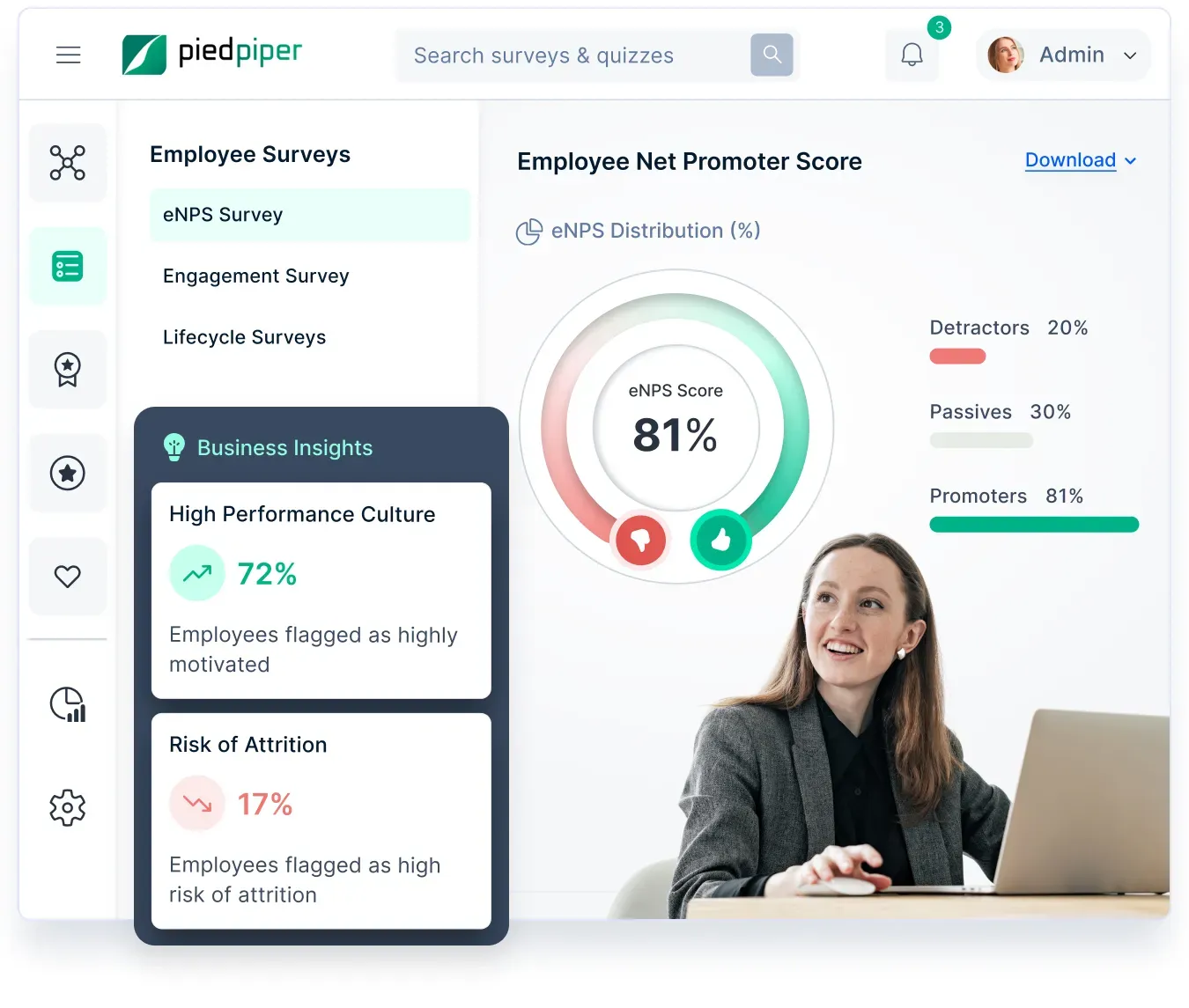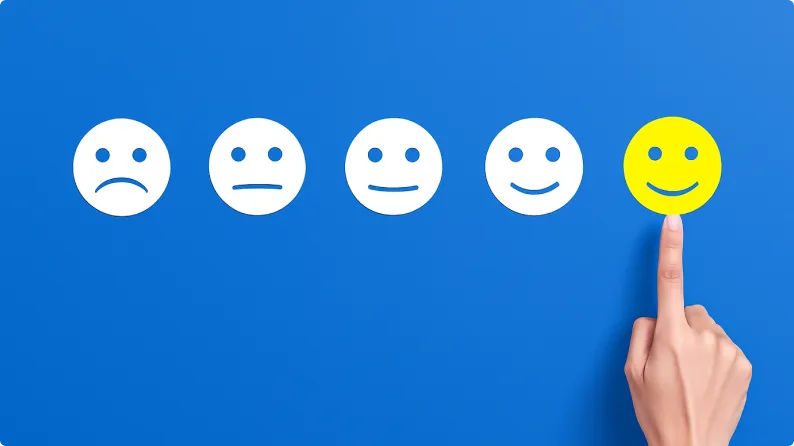Employee Pulse Survey: A Smarter Way to Retain Top Talent
An employee pulse survey is a powerful tool for measuring workplace engagement and addressing employee concerns in real time. Unlike traditional surveys, pulse surveys provide frequent insights to help businesses track sentiment, boost retention, and make data-driven decisions.
On this page
Attracting the best employees is only half the battle—retaining them is what truly drives long-term success. With voluntary turnover costing U.S. businesses nearly $1 trillion annually, companies need a proactive approach to understand employee sentiment and address workplace challenges before they lead to disengagement.
This is where the employee pulse survey becomes invaluable. Unlike traditional annual surveys, pulse surveys provide real-time insights into employee morale, job satisfaction, and workplace concerns. By collecting frequent feedback, organizations can identify issues early, make data-driven improvements, and boost retention rates.
But simply running surveys isn't enough. Understanding how to use employee pulse surveys effectively ensures businesses get the most out of employee feedback.
In this pulse survey guide, we will walk you through everything you need to know—from designing impactful questions to analyzing results and driving real change.
What are employee pulse surveys?
An employee pulse survey checks the "pulse" of employees, and its result indicates if the company is in a healthy or unhealthy state. Pulse surveys help HR leaders collect information and regularly assess employees' feelings about their jobs and the company, especially on operational or strategic issues.
These surveys measure employee satisfaction, loyalty, and engagement, providing companies with the data they need to make informed and proactive decisions.
Most HR departments have traditionally relied on formal, large-scale surveys to gauge employees' feelings.
While these, often annual, employee surveys are far from extinct; they are clearly on the decline because they are too lengthy, provide outdated data, and have little impact since the actions taken tend to be reactive.
Issues with annual surveys have led to the rising popularity of employee pulse surveys, and as a result, we believe every company should use pulse surveys.
Why employee pulse surveys are important?
Unlike the annual engagement surveys, companies should use pulse surveys more frequently because they play a significant role in improving company culture.
Since it's not advisable to wait for an entire year to evaluate whether morale has gone up or down, you'll find pulse surveys useful because they:
1. Provide real-time insights about your company
Over the years, Gallup's research showed that most employees are not engaged—stating that only 15% worldwide and just 34% in the U.S. are engaged.
In May 2020, the percentage of engaged workers in the U.S. saw a historic climb to 38%. However, one month later, Gallup recorded the most significant drop in their history of tracking employee engagement in the U.S., dating back to 2000.
Seeing how the engagement data fluctuated within one month, you can see that it's unreasonable to wait for an entire year to track employee engagement at your organization.
So, pulse surveys for employee engagement can help you notice such fluid changes in real time, detect warning signs, show areas for improvement, and take proactive next steps.
2. Elicit a high response rate from employees
Questions used for employee pulse surveys are often concise and easy to complete, which elicits more responses. The more answers you receive, the more data you have to identify issues and themes - and better the pulse survey results.
3. Allow HR leaders to use analytics to drive impact
It's no secret that HR professionals consistently seek a seat at the table. In other words, HR leaders request to participate in strategic decision-making and drive significant impact within their organizations. Why is this such a struggle for HR?
One way HR can earn their CEO's trust is to use analytics to anticipate business needs.
HR managers can predict problems before they surface by using HR metrics, such as productivity, turnover, retention, or engagement rates. As an HR leader, understanding pulse surveys can provide you with the data you need to play a more strategic role.

Download Free Survey Templates to Capture Employee Sentiment
Use expert-designed templates to track employee engagement, job satisfaction, and workplace culture. Get instant access to the templates that fit your needs.
6 Factors to consider before using pulse surveys
When deciding to use pulse surveys for your company, we think it's essential for you to consider the following factors:
1. Support
As an HR leader, you will need executive support for your HR initiatives. Still, management buy-in will likely occur after you have shown them the business impact of using pulse surveys for employee engagement.
Let your business leaders know the kind of data they can expect and how it will help the organization.
2. Communication
After leaders endorse using pulse surveys, they must encourage employees to participate.
According to Gartner, once leaders can answer the question, "What's in it for me?", then half the battle for high response rates is already won.
➡ Inform them of how and when you will invite them to participate. Employees should know what to expect while completing the surveys.
➡ Let employees know who can access their responses and if they have the option to remain anonymous.
3. Transparency
To make your employees trust your feedback process and be more willing to participate in future pulse and employee engagement surveys, they will need to know each employee’s pulse survey results and understand your company's improvement plans.
Be prepared to bring employees up to speed with the employee pulse survey results and solicit their involvement in planning the next steps.
5. Frequency
Determine how often you plan to administer the pulse surveys. Pulse surveys should be more frequent than once, meaning you may use them monthly, quarterly, or biannually.
However, in doing so, ensure that your employees do not experience survey fatigue—when people stop responding to surveys because they think their feedback isn't relevant.
➡ How likely will the data change within a week, month, or quarter? Has a significant change occurred in your company, such as a restructuring or mass layoff? Questions like these can help you determine the frequency of your pulse surveys.
➡ How feasible is it to take meaningful action on surveys - Has the company made any progress since the last survey? Employees must see such improvements before they can willingly participate in subsequent surveys.
6. Design
➡ Survey length and duration: Keep the questions concise and straightforward. Consider asking 5 -15 questions that can be answered within 5 minutes.
➡ Question structure: Consider using different survey questions such as multiple-choice, Likert scale, matrix, rating scale, or open-ended questions.
Use your questions to ask for employee feedback around specific topics so that you can track changes over time. Topics may include workplace culture, diversity, and inclusion, rewards and recognition, or work-life balance.
7. Pulse survey software platform
Understand that there's no one-size-fits-all pulse survey app and platform, so what worked for a different company may not necessarily work for yours.
When evaluating pulse survey apps and platforms for your company, you should be asking these questions:
- ✅Is the platform cost-effective?
- ✅ Is it user-friendly?
- ✅ Is the design mobile responsive?
- ✅ Does it ensure total anonymity for respondents?
- ✅ Can it be customized to our needs?
- ✅ Does it ensure data security and backup?
- ✅ How easy is it to collect and analyze reports?
For example, our all-in-one employee engagement platform, Empuls, answers all the questions above and more.
Through Empuls, you can efficiently run and manage pulse surveys, measure employee engagement in real time, and turn feedback into actionable insights. It is one of the best pulse survey software for organizations to keep track of employees' pulse.
Our pulse survey platform also offers ready-to-use and research-backed survey templates for different aspects of the employee lifecycle, such as onboarding, learning, wellness, diversity, and exits.
We can configure the cadence, questions, and audience to meet your requirements. Most importantly, we ensure anonymity for all responses.
Role of managers in implementing the pulse survey process
Managers play a critical role in making the employee pulse survey process effective. They bridge leadership and employees, ensuring that survey insights lead to meaningful actions. Here’s how managers contribute at every stage of the pulse survey process:
1. Encouraging employee participation
Managers set the tone for engagement. When they emphasize the importance of pulse surveys and reassure employees that their feedback is valued, participation rates increase. Open communication about the survey’s purpose fosters trust and encourages honest responses.
2. Framing the right questions
While HR teams design the surveys, managers provide valuable input on what questions to ask. Since they interact with employees daily, they understand key workplace concerns and can help tailor questions that yield actionable insights.
3. Analyzing and interpreting feedback
Managers should work closely with HR to analyze survey results and identify trends. Understanding engagement patterns within their teams allows them to pinpoint issues, recognize successes, and develop improvement strategies.
4. Taking action on survey insights
The effectiveness of a pulse survey depends on what happens after the results come in. Managers must act on feedback by implementing team-specific changes, whether it’s improving communication, addressing workload concerns, or fostering a more inclusive work environment.
5. Communicating results transparently
Employees need to see that their feedback leads to real change. Managers should share key survey findings with their teams, acknowledge areas for improvement, and outline concrete steps being taken to address concerns. Transparency builds trust and boosts future participation.
6. Monitoring progress and continuous improvement
Pulse surveys are not one-time events. Managers must track progress, compare new results with past data, and adjust their strategies accordingly. A constant feedback loop ensures that engagement efforts stay relevant and effective.
By actively participating in the pulse survey process, managers create a culture where employee voices are heard, valued, and acted upon. Their involvement ensures that pulse surveys drive meaningful change rather than becoming just another HR initiative.
How to use employee pulse surveys: Best practices that drive real impact?
A well-executed employee pulse survey goes beyond collecting data—it should identify real engagement challenges and lead to measurable improvements. Here’s how to ensure your pulse surveys generate actionable insights and meaningful change.
1. Ask targeted questions that address real workplace issues
Generic questions like "Do you feel engaged?" provide little value. Instead, focus on specific engagement drivers such as workload balance, manager support, career growth, and recognition. For example, instead of “Are you happy with your job?”, ask “Do you feel your work is recognized and valued by leadership?”
2. Customize survey cadence based on business needs
Not every company needs a weekly or monthly pulse survey. Determine the frequency based on organizational changes, team dynamics, and engagement goals. For high-turnover environments, monthly surveys help track shifting sentiment. For stable teams, quarterly surveys may be more effective.
3. Use AI and real-time analytics to spot trends
Traditional survey reports often take weeks to analyze, making insights outdated by the time action is taken. Platforms like Empuls provide real-time AI-driven analytics, allowing HR and managers to detect dips in engagement and respond proactively and quickly.
4. Close the feedback loop with transparent communication
Employees disengage when surveys feel like a one-way street. After every pulse survey, share three key takeaways, acknowledge concerns, and outline specific actions being taken. If survey results indicate burnout, discuss workload redistribution or mental health initiatives.
5. Align pulse survey insights with business decisions
Engagement data should drive strategic decisions, not sit in an HR dashboard. If surveys reveal a decline in leadership trust, use insights to refine manager training programs. If remote employees report feeling disconnected, introduce virtual engagement initiatives.
A well-structured pulse survey process doesn’t just track engagement—it empowers leaders to act on real-time data and create a workplace where employees feel heard, valued, and motivated.

Measure Employee Sentiment in Real Time with Pulse Surveys
Keep track of engagement levels with Empuls’ employee pulse survey. Get instant feedback, identify concerns, and take action to create a more engaged workforce.
How do you administer employee pulse surveys?
Once you've considered all the factors above, you can then go ahead with administering your pulse survey in these simple steps:
- ➡ Announce the survey: As discussed above, you can improve your chances of getting a high response rate by sharing all the details employees need to know about the survey. Preferably, you can have the CEO announce the survey for better effect.
- ➡ Launch the survey: Send the survey link to employees. You can use both emails and text messaging so that they can use whichever is accessible.
- ➡ Send reminders: It's necessary to remind employees during meetings or conversations so that the pulse survey remains a priority for them.
- ➡ Share results and analyze findings: After closing the survey, you'll need to share the pulse survey results with employees and analyze the findings. You can create focus groups to identify themes, address specific issues, and brainstorm possible organizational solutions.
- ➡ Plan post-survey actions: This is the crux of the pulse survey process. Your executive team and employees must know the next steps, including a feasible timeline and the people involved. This stage will also determine the likelihood of high future response rates.
- ➡ Repeat: You will need to repeat the process regularly. However, remember to avoid survey fatigue. As mentioned earlier, employees would need to see improvements before they can willingly participate in subsequent surveys.
Check out the next part of our resource guide, which shares 15 pulse survey questions you should ask your employees.
Turning employee pulse survey results into actionable change
A pulse survey is only as effective as the action it drives. Too often, companies collect feedback but fail to translate it into meaningful improvements. Employees quickly recognize when their input doesn’t lead to change, which can erode trust and lower participation in future surveys. To ensure survey results drive real impact, here’s how organizations can analyze, communicate, and act on pulse survey insights effectively.
1. Look beyond scores—identify root causes
Many organizations focus on engagement scores without investigating why certain areas are thriving or struggling. A low score on “Do you feel valued at work?” isn’t just a number—it signals deeper issues like lack of recognition, limited career growth, or weak leadership support. Instead of reacting to numbers alone, analyze open-ended responses and cross-check with previous survey trends to uncover underlying causes.
2. Segment data to uncover hidden patterns
Aggregated results can hide critical engagement gaps within teams or job levels. Instead of looking at company-wide engagement scores, break down results by department, seniority, tenure, and location.
A company-wide engagement score of 70% may seem healthy, but if new hires in one division score 50%, the problem is not engagement—it’s onboarding, unclear expectations, or poor leadership within that team.
3. Prioritize “high-impact” issues over surface-level fixes
Not all engagement concerns carry equal weight. Some issues, like communication gaps between teams, may be minor inconveniences, while others—such as high stress levels due to unmanageable workloads—can directly impact retention and performance. Prioritize high-impact engagement barriers that affect business goals, turnover risk, and productivity rather than making cosmetic improvements.
4. Communicate findings with transparency and accountability
One of the biggest mistakes companies make is withholding results from employees. If employees take the time to provide honest feedback, they expect to see it acknowledged. Instead of vague statements like “We appreciate your input and will work on improvements,” be specific:
- “Survey results show that 42% of employees feel unclear about career growth opportunities. In response, we are launching a structured mentorship program by next quarter.”
- “Only 30% of employees feel leadership is accessible. To address this, we will implement monthly Q&A sessions between employees and senior leaders.”
This level of transparency builds trust and signals that leadership takes feedback seriously.
5. Take immediate action, then track progress over time
Making visible, meaningful changes quickly increases participation in future pulse surveys. If a pulse survey highlights lack of recognition, don’t spend months designing a perfect solution—start with immediate changes like peer recognition programs, then refine over time.
Additionally, track engagement scores over multiple survey cycles. If scores in a previously weak area don’t improve despite changes, it may indicate that the root issue wasn’t fully addressed or that additional interventions are needed.
Empuls: Capture real-time employee sentiment with pulse surveys

Understanding employee sentiment in real-time is essential for fostering engagement and reducing turnover. Empuls' employee pulse survey tool helps organizations gather frequent, meaningful feedback to track engagement trends, address concerns, and enhance workplace satisfaction.
Why choose Empuls for employee pulse surveys?
- Automated & AI-Powered Surveys: Schedule recurring pulse surveys and get AI-driven insights to identify engagement trends before they become problems.
- Anonymity for Honest Feedback: Encourage employees to share candid responses with confidential and bias-free surveys that promote transparency.
- Real-Time Analytics & Actionable Insights: Instantly access reports highlighting key engagement drivers, making it easier to act on feedback quickly.
- Customizable & Research-Backed Templates: Use pre-built templates or tailor questions to fit your organization's specific engagement goals.
- Seamless Integration: Connect with Slack, Microsoft Teams, and other workplace tools, making it easy for employees to participate without disrupting workflow.
👉 Start using Empuls pulse surveys today
Final thoughts on employee pulse surveys
A well-designed employee pulse survey is more than just a feedback tool—it’s a proactive approach to understanding workplace sentiment, identifying concerns, and fostering a culture of continuous improvement. Organizations can boost engagement, improve retention, and enhance employee satisfaction by collecting frequent, real-time insights.
However, the real impact of pulse surveys lies in how organizations use the data. Simply gathering feedback isn't enough—analyzing trends, taking swift action, and communicating changes transparently is key to making pulse surveys effective. When employees see their feedback leading to actual improvements, trust increases, and engagement follows.
By implementing best practices, leveraging AI-powered analytics, and ensuring follow-through, businesses can create a more responsive, engaged, and motivated workforce.
FAQ's
1. What are the common uses of pulse surveys?
Pulse surveys are used to track employee engagement, job satisfaction, workplace culture, leadership effectiveness, and reactions to company changes in real time.
2. What can pulse surveys measure?
They measure morale, motivation, workload balance, career growth satisfaction, leadership trust, team collaboration, and overall workplace sentiment.
3. How often should you use pulse surveys?
Monthly or quarterly is ideal. Frequency depends on organizational needs—more frequent for fast-changing environments, less frequent to avoid survey fatigue.
4. How long should a pulse survey be?
A pulse survey should take 5 minutes or less, typically containing 5-15 targeted questions to ensure high participation without overwhelming employees.
5. What about survey fatigue?
To avoid fatigue, keep surveys short, rotate questions, ensure anonymity, and act on feedback so employees see real changes based on their input.
6. What are the best employee pulse survey questions?
The best questions focus on engagement, recognition, workload, leadership support, and team dynamics, such as:
- Do you feel valued at work?
- Is your workload manageable?
- Do you receive enough feedback from your manager?
- Do you see career growth opportunities here?
- Would you recommend this company as a great place to work?















